ASUS TUF Z97 Mark S Motherboard Review: The Arctic Camo Special Edition
by Ian Cutress on November 10, 2014 10:00 AM EST- Posted in
- Motherboards
- Asus
- TUF
- Z97
- Sabertooth
CPU Benchmarks
Readers of our motherboard review section will have noted the trend in modern motherboards to implement a form of MultiCore Enhancement / Acceleration / Turbo (read our report here) on their motherboards. This does several things, including better benchmark results at stock settings (not entirely needed if overclocking is an end-user goal) at the expense of heat and temperature. It also gives in essence an automatic overclock which may be against what the user wants. Our testing methodology is ‘out-of-the-box’, with the latest public BIOS installed and XMP enabled, and thus subject to the whims of this feature. It is ultimately up to the motherboard manufacturer to take this risk – and manufacturers taking risks in the setup is something they do on every product (think C-state settings, USB priority, DPC Latency / monitoring priority, memory subtimings at JEDEC). Processor speed change is part of that risk, and ultimately if no overclocking is planned, some motherboards will affect how fast that shiny new processor goes and can be an important factor in the system build.
For reference the ASUS TUF Z97 Mark S in our setup, with BIOS 2102, did implement a form of MultiCore Turbo.
Point Calculations – 3D Movement Algorithm Test: link
3DPM is a self-penned benchmark, taking basic 3D movement algorithms used in Brownian Motion simulations and testing them for speed. High floating point performance, MHz and IPC wins in the single thread version, whereas the multithread version has to handle the threads and loves more cores.
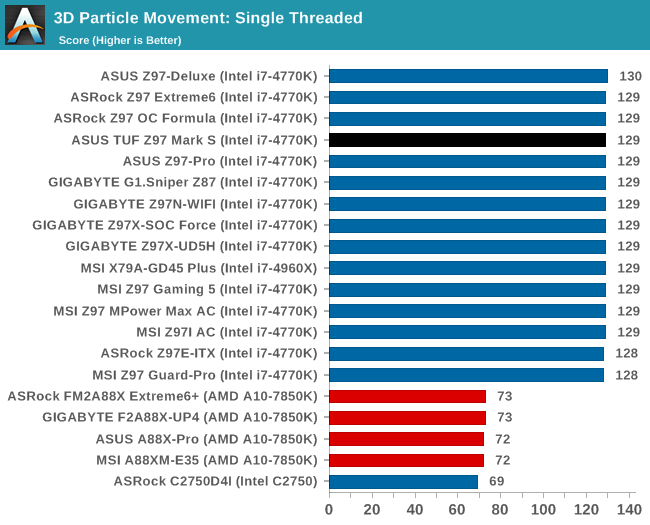
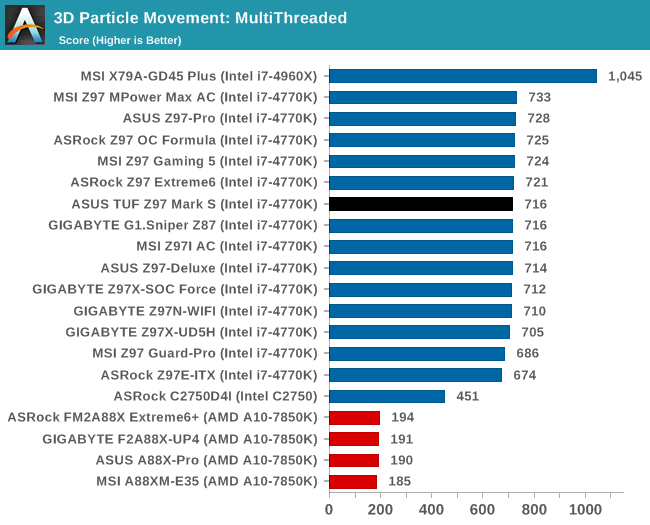
Compression – WinRAR 5.0.1: link
Our WinRAR test from 2013 is updated to the latest version of WinRAR at the start of 2014. We compress a set of 2867 files across 320 folders totaling 1.52 GB in size – 95% of these files are small typical website files, and the rest (90% of the size) are small 30 second 720p videos.
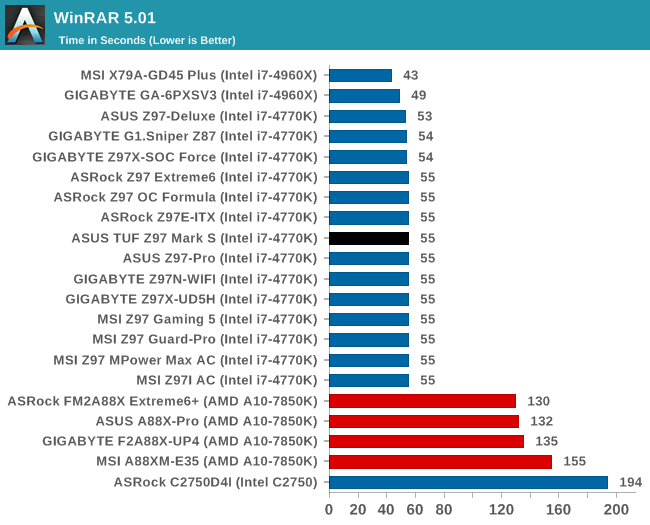
Image Manipulation – FastStone Image Viewer 4.9: link
Similarly to WinRAR, the FastStone test us updated for 2014 to the latest version. FastStone is the program I use to perform quick or bulk actions on images, such as resizing, adjusting for color and cropping. In our test we take a series of 170 images in various sizes and formats and convert them all into 640x480 .gif files, maintaining the aspect ratio. FastStone does not use multithreading for this test, and thus single threaded performance is often the winner.

Video Conversion – Handbrake v0.9.9: link
Handbrake is a media conversion tool that was initially designed to help DVD ISOs and Video CDs into more common video formats. The principle today is still the same, primarily as an output for H.264 + AAC/MP3 audio within an MKV container. In our test we use the same videos as in the Xilisoft test, and results are given in frames per second.
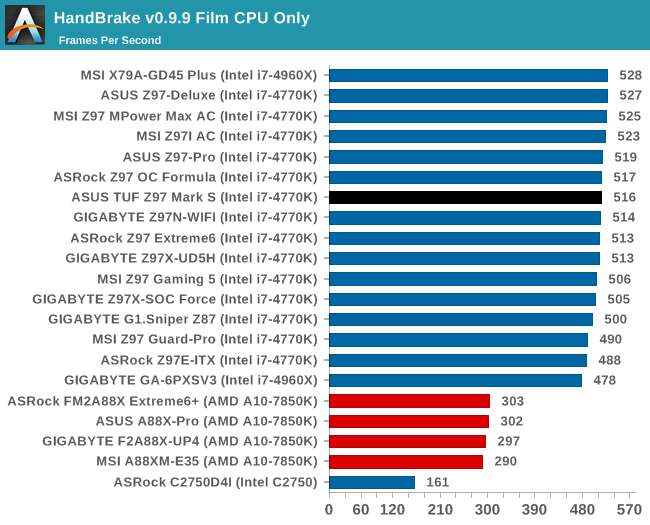

Rendering – PovRay 3.7: link
The Persistence of Vision RayTracer, or PovRay, is a freeware package for as the name suggests, ray tracing. It is a pure renderer, rather than modeling software, but the latest beta version contains a handy benchmark for stressing all processing threads on a platform. We have been using this test in motherboard reviews to test memory stability at various CPU speeds to good effect – if it passes the test, the IMC in the CPU is stable for a given CPU speed. As a CPU test, it runs for approximately 2-3 minutes on high end platforms.
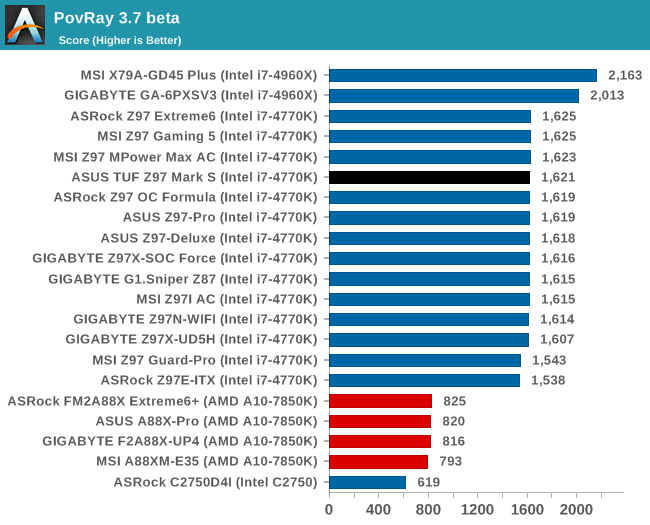
Synthetic – 7-Zip 9.2: link
As an open source compression tool, 7-Zip is a popular tool for making sets of files easier to handle and transfer. The software offers up its own benchmark, to which we report the result.
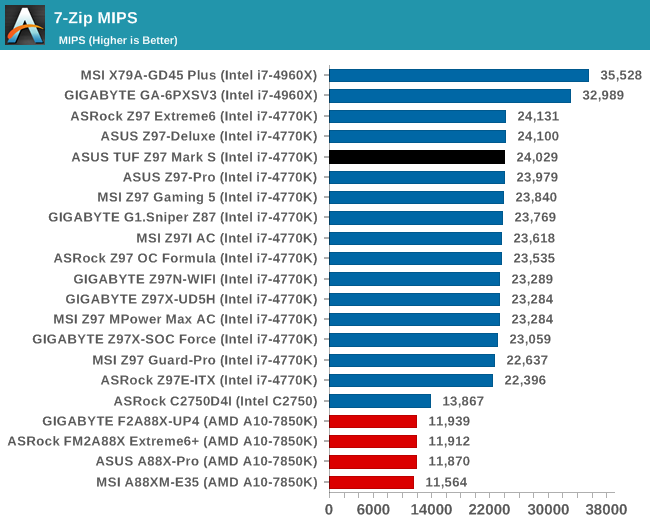










45 Comments
View All Comments
WithoutWeakness - Monday, November 10, 2014 - link
Solid board with good looks. The last paragraph is on point and more than one person will most certainly pair this with a GALAX HOF card, some Dominator Platinums, and white LEDs throughout for a very clean, high-performance rig. Glad to see more options on the market, especially considering the recent trend of every manufacturer pumping out black/red boards.MrRez - Wednesday, November 26, 2014 - link
Here is my build using this board as the centre piece :)http://linustechtips.com/main/topic/257519-my-firs...
lilmoe - Monday, November 10, 2014 - link
If a screw falls in there, you're "screwed".Yuriman - Monday, November 10, 2014 - link
Plastic covers over hot components, requiring the use of small fans seems like a bad idea.Flunk - Monday, November 10, 2014 - link
Never fear, the plastic doesn't actually cover anything hot. It serves basically no purpose past dust protection and looking pretty, but it shouldn't cause any overheating.Don't get me wrong, I love ASUS (I have a P8Z68-v PRO in my gaming desktop), but the "thermal armor" thing is totally pointless. It wouldn't stop me from buying a board, but it's entirely for looks.
Samus - Monday, November 10, 2014 - link
it does look good, for those that care. me, well, I put a cover on my case and might look in there 2 years later...Wwhat - Thursday, November 27, 2014 - link
I think the idea might be that the CPU cooler and GPU cooler's heat that gets into the case doesn't get to the motherboard? Or maybe it's just nonsensical bullshit, *shrug*pocketdrummer - Friday, April 17, 2015 - link
Actually, it still seems like a bad design especially if it's for dust protection. They put an UNFILTERED intake fan on the rear of the computer (right next to the exhaust fans, mind you) and pipe it underneath the plastic cover. If anything, you're going to inject dust up underneath the cover that's supposed to prevent dust.This makes no sense.
Basically it looks cool. That's about it.
Tamarocker88 - Monday, July 13, 2015 - link
The intake fan on the rear of the computer is actually filtered. There's a small removable filter included. As for dust getting stuck under the plastic cover, the BIOS includes fan controls to automatically reverse the flow of the board's fans periodically, preventing buildup. This combined with the bottom and front of the case having removable filters should provide for a great dust protection system.ZeDestructor - Monday, November 10, 2014 - link
I have the older Sabretooth Z77 right now. I installed, then removed the fans, and there was no meaningful change in temperatures.